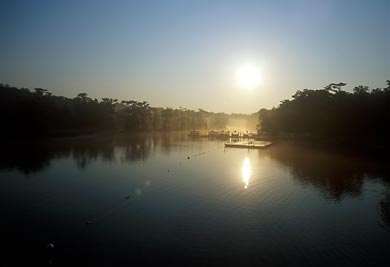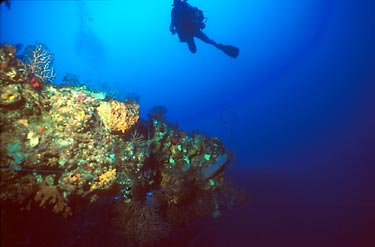Aesthetic Environmentalism
Aesthetic EnvironmentalismBY DR. DAVID E.W. FENNER
My sister is a huge fan of scuba diving. As I write this, she is diving in the Cayman Islands, a follow up dive trip to her recent one to Fiji. When we have the occasion to see one another, after her return from one of these trips, she always has three or four books filled with underwater photographs. It is very clear to me, and to her, that her reason for going on these trips, spending her money and her vacation time on diving, is her deep appreciation for the beauty of the underwater world. I suspect that many scuba-diving aficionados find that their primary motivation to spend their resources in pursuit of scuba-diving experiences is like my sister's. But it is not merely those who appreciate the underwater world who appeal to its beauty as a reason to experience it and to preserve it. Many environmental ethicists -- both professional and avocational -- appeal to aesthetic considerations when articulating their reasons for advocating protecting and preserving the natural world. In fact, many of us report that our first aesthetic experiences occurred not in art galleries or in performance halls, but in nature. Moreover, many report that they continue to find that some of their strongest and richest aesthetic experiences are natural. Using aesthetic terminology as robust and varied as New York gallery critics, people freely relate stories about natural encounters, about an overnight camping trip, a hike through the woods, canoeing a river, or a dive trip. This is common, and it is also common to find these same sorts of people are ones advocating preservation of the natural contexts that first afforded them deep and lasting aesthetic experiences. In this brief article, I want to make three points concerning parallels we can see between the natural world and the world of art. First, I want to talk about diversity. Next, I want to talk about preservation. And, finally, I want to talk about how we may approach nature and art aesthetically. I hesitate to call anything centrally paradigmatic or canonical anymore, but suffice it to say that there are certain aesthetic contexts that are more popular or common, at least in America, than are others. One of these common aesthetic contexts is an art gallery, where its audience expects diversity. That diversity may have a great range as we find in a museum where the collection includes early renaissance works, baroque works, impressionist works and also perhaps pop works. Or the diversity may be limited, as in the case of a gallery specializing in art works ranging from the 1970s to the 1990s. Or, finally, a gallery's diversity may consist in artworks of different media, moving from the two-dimensional to the three-dimensional. Yet in almost all gallery experiences, viewers will have the opportunity to experience a range of artworks demonstrating a variety of styles. This is how it is with natural areas, too. The natural world is highly diverse. Within the space of only a few dozen acres, one may find several different natural community types, each with its own plant and animal life. With each different natural community type is found a whole new ecosystem. The functional integrity of those different systems is based on the variety of plant and animals found there and the fact that their lives are closely interrelated. Remove one part of the system, and the integrity is lost. In some cases, the removal of one species from an ecosystem can result in the collapse of the entire system. In addition to the variety of living elements, ecosystems are defined in terms of the inanimate contexts of those life forms. Again: change the hydrology or the climate of a particular area, and that area's ecosystem will change radically, too. There is a common misconception that what needs saving is only some identifiable and conceptually isolatable piece of nature. "If only we could save the wetlands." But this is ecologically specious. The wetlands, to take that case, only function with integrity when there is contiguous functional exchange and overlap with uplands, lands that are not wet. Without the uplands, the wetlands' functional integrity is diminished. To find a great area of wetlands is unusual; certainly they occur, but they are unusual. It is much more common to see a regional interplay between wetland and upland. Moving from one natural community type, one sort of land, to another is like moving from room to room in a gallery, leaving one style for another. Although to straightforwardly treat a natural ecosystem as if it were an art gallery is to invite problems, the point is that there is a parallel between the diversity expected in our most common forms of aesthetic attention -- the visit to the art gallery -- and the variety which will be found in any functionally thriving ecosystem.As we believe it is appropriate to work to preserve artworks in a museum for the sake of future viewers, we may also think it is appropriate and important to preserve the natural world as a source of future rewarding aesthetic experience. In the case of art, when seeking to preserve artworks we work to maintain the original state of objects. Can this be the same when seeking to preserve nature? No, seeking to preserve a particular natural area -- bordered perhaps by visual framing, by land development, or by ecosystem integrity --cannot mean that we will try to keep it exactly as it was when we first encountered it. This is impossible. Even the moonscape changes by collision and entropy. Moreover, this cannot be recommended. To preserve a natural area in a state in which a particular human being first encountered it is, not to point too fine a point on it, unnatural. To understand nature is to understand it as dynamic. If nature is dynamic and changing, then the integrity of nature is preserved when that dynamism is preserved. Separate the dynamism from nature and one has removed a part of nature's integrity. If nature tends toward diversity and variety, then preservation of nature means that nature's ability to change and diversify must be protected. The parallel between the art gallery and the natural world only goes so far. What about how we approach each, the way we prepare ourselves in anticipation of aesthetic enjoyment? Does the parallel between the art world and nature hold up here? One of the most philosophically popular theories of how one should approach aesthetic objects is the theory of disinterest (attributed, in various forms, to Kant, Schopenhauer, Stolnitz and a host of others). Under this view, to approach an object with disinterest is to consider it only on its own terms. I consider it without interest in what it might be used for or how it might be made to serve me. I keep the object at a distance. I am detached. In contrast to this view is the less popular one that defends an attitude of interest, engagement and involvement. Is there a right way for us to approach the aesthetic enjoyment of nature? Should we appreciate it from afar, from an approach that is detached and disinterested? Or should the approach be one of connectedness and interest? Arnold Berleant, in his book, The Aesthetics of Environment (Philadelphia: Temple University Press, 1992), clearly prefers the connected approach. Indeed, he extends the model (rightly, and in the right direction, in my view) to say that the greater the sensory engagement and involvement -- he coins the word "synaesthesia" for the complete union of sensory modalities -- the greater the depth of appreciation, identity, and recognition of interconnectedness. And it is these things that will ground the deepest motivation for protection and defense. Environmental appreciation cannot be directed toward an object for there is none. Appreciative engagement must replace the customary contemplative admiration. The boundlessness of the natural work does not surround us; it assimilates us (Berleant, pp. 131, 159). Berleant's paradigm of aesthetic environmentalism is a sort of participatory aesthetic where the lines between human and nonhuman nature are blurred. From this perspective, an attitude which seeks to find kinship with the natural context will afford one aesthetic experiences that are more genuine, deeper and more motivating. When all of my sensory modalities are engaged, when my thoughts and feelings are engaged, there I am totally immersed; there I can have the deepest, richest, most highly unified aesthetic experiences of which I am capable. It stands to reason that within such an experience will flow the most genuine concern for those contexts that provoked it. The most highly motivated environmentalists I encounter are not academics, or at least they are not the all-too-familiar cloistered ones. The environmentalists that feel their call and commitment to protect nature the deepest are those who spend regular and sustained "quality time" out in the woods, in the mountains, on the rivers, and underwater.
I want to close with one caveat. Aesthetic theories regarding the value of nature, as underpinning reasons for cherishing and protecting natural objects and areas are highly relevant to environmentalism, both theoretic and applied, today. But aesthetic environmental theories offer only a part of the whole environmental story. There are many natural objects and areas that do not hold the promise of sustained reward for aesthetic attention. Should we not protect the ugly ducklings, too? There are many natural areas that are aesthetically unattractive and unrewarding; surely we do not want to limit our environmental concern only to those areas which we find aesthetically engaging, do we? The point is that while aesthetic theorizing today is necessary to environmental thought, it is not sufficient. The promise of aesthetic experience is only one service the natural world offers me. It offers me lots more, too. There is more value there than we have thus far recognized. But at the same time, we ought to be moderate in our theories, realizing that we are a part of nature and that as such it may be hubris to blanket the world with human values. We must not seek to control nature. As Berleant says, nature assimilates us. We are but one part, and there are hosts of natural relations that are but very distant cousins to our concerns and us.Copyright ©2004 Global
Underwater Explorers.
All rights reserved. |



